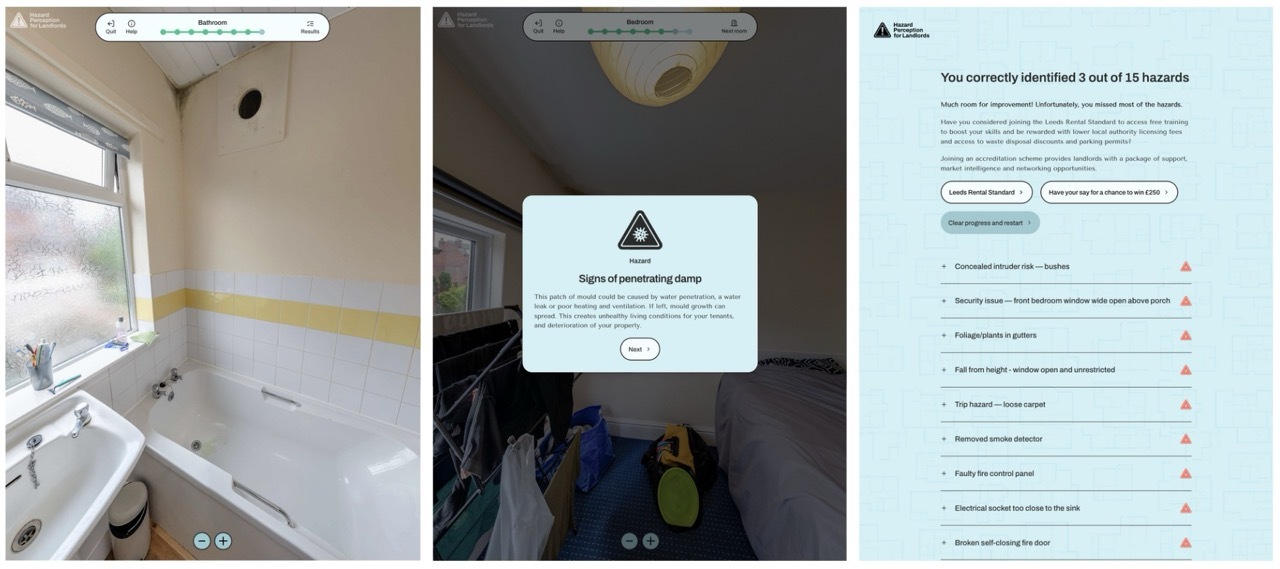Background
The Private Rented Sector (PRS) represents 22% of Leeds’ housing stock. Although many PRS homes are of a decent standard, there are a significant proportion that are characterised by poor management and maintenance, leaving tenants living in suboptimal, or even unsafe conditions - significantly impacting their quality of life.
In this project, we took a behavioural approach to driving up standards in the PRS, by designing and delivering three different interventions aimed at changing the behaviour of well-meaning landlords who may be unknowingly or unintentionally falling short of their obligations. Results from an independent process evaluation and analysis of online engagement showed that the interventions were robust and had potential to drive meaningful change.
Insight
Initial desk research uncovered five key issues present in the PRS: mould, cold, disrepair, distrust and insecurity. Cold, mould and disrepair are physical issues that occur when landlords fail to carry out maintenance and/or respond to tenant repair requests; distrust is a psychological issue stemming from poor relationships between landlords and tenants; and insecurity is a social issue, occurring when tenants feel uncertainty and powerlessness over things like rent increases and length of tenancy. All of these issues significantly impact tenant’s ability to feel at home in their PRS properties.
These issues and the behaviours underpinning them were explored further in primary qualitative research with landlords, tenants and letting agents. This research led to three key insights which unlocked strategic opportunities for intervention:
- What makes a property ‘acceptable’ feels subjective; everyone sees it differently. For example, a tenant may see an issue as something broken, requiring repair; a landlord may see the same issue as a non-essential upgrade. This meant we needed to show landlords what ‘unacceptable’ actually looks like
- Landlords assume that ‘no complaints’ means ‘no problems’. However, there may be a host of reasons tenants don’t contact their landlord about problems, including uncertainty and fear of reprisals - this means that unsolved problems get worse for both landlords and tenants. This uncovered a strategic opportunity to encourage landlords (and agents) to be proactive about checking for issues
- Many landlords underrate the value of having a professional relationship with tenants. All landlords vetted tenants due to fear of a ‘bad’ one, but not all invested effort into communicating with and retaining ‘good’ tenants - with more positive relationships being associated with longer tenancies and better care of the property. We therefore saw an opportunity to upskill landlords in relationship-building and how to do it
Intervention
We designed three different interventions drawing on a range of behavioural tools - one to tackle each strategic opportunity:
1) Hazard Perception Test
Showing landlords what ‘unacceptable’ actually looks like with a gamified online experience, walking through a real PRS home with hazards (for example damp, damaged electrical sockets and insufficient heating) scattered throughout. Landlords were asked to click when they saw a hazard and were given a score at the end (along with guidance on what they missed and tips on how to fix hazards).

2) Property MOT Month
Encouraging landlords to proactively check for issues with a month-long communications campaign around Leeds. Seven priority checks were identified and formed the basis of the communications, also chunking the inspection process into manageable steps. The public nature of the campaign applied pressure onto landlords, as it was also visible to tenants (who may therefore expect property checks), and it implied other landlords were checking too.
3) Tenancy Take-Off Toolkit
Upskilling landlords in relationship-building and how to do it with a personalised and customisable toolkit all about their rental property, designed to be shared with tenants in a face-to-face welcome meeting - giving landlords the tools to lay the foundations for a positive relationship. The toolkit covered important, often overlooked information and laid out responsibilities and expectations on both sides, also helping to prevent future communication issues.
Implementation
Each of our interventions had its own microsite where landlords were directed to access the materials (the Hazard Perception Test experience, Property MOT Month checklist and Tenancy Take-Off Toolkit).
Landlords are notoriously challenging to reach, as they often don’t self-identify as such. Therefore, we developed a broad brush communications plan, which included social media advertising, emailing from a range of relevant mailing lists, Google Ads, and for Property MOT Month, advertising on billboards, buses, digital screens, and radio.
All three interventions were live during late 2024 for 6-10 weeks.
Impact
Microsite data revealed that:
- 19,490 people visited the Hazard Perception Test website, with 694 completing the whole experience
- 27,253 people visited the Property MOT Month website - and there were an estimated 3 million impressions on our billboards, bus ads, digital screens and radio ads across Leeds
- 26,036 people visited the Tenancy Take-Off Toolkit website, and 247 of them completed and downloaded a toolkit
Measurement of longer term behaviour change as a result of our interventions was not possible within the time and budget constraints, however the microsite data and the results from an independent process evaluation we commissioned suggest that the interventions were viewed very positively (especially the Hazard Perception Test), and had robust designs grounded in sound theory. The full report for this project and its evaluation will be published shortly.